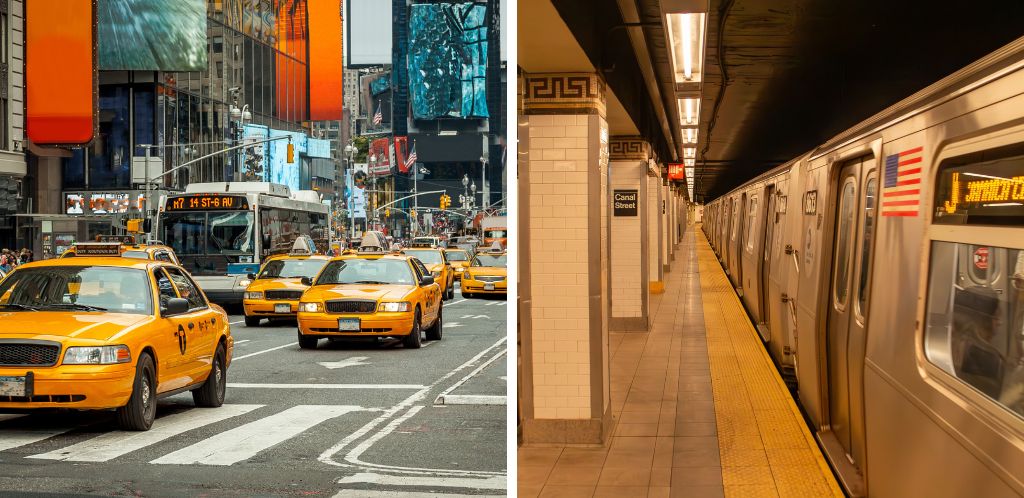Cost of living in USA: Food, transport, and more
Discover the cost of living in the United States in 2025. We provide examples of prices for accommodation, transport, food, and more.
The cost of living in USA is higher than in most countries. But how expensive is life there? How much are monthly expenses? If you’re considering spending time there, you should budget for housing, food, transport, and leisure.
To help you, we’ve researched and created a post with real prices. We’ll explain how much to budget for housing, food, healthcare, and internet. Prices vary a lot depending on the state or city where you live. Join us to discover your possible monthly expenses.
Plans that may interest you
1. Average cost of housing in the US
Let’s start with the main part of your budget: housing. Prices differ greatly depending on whether you live in a big city, a smaller one, or a town. States also show big variations. In the country’s interior, options are usually more affordable.
It’s no secret that houses or rentals in the US aren’t cheap. According to 2025 data, rental prices rose by 8% in the last year. In large cities, the rise was even higher. Here are approximate prices you’ll find on booking or rental sites:
1.1. Furnished apartment rentals
Rental costs change a lot depending on the area. Which cities are the most expensive? You’ll pay higher monthly rents in New York, San Francisco, and Los Angeles. In Houston or Charlotte, you’ll find more affordable prices.
It also depends on location. You can save up to 40% in suburban neighbourhoods. For example, here are average monthly rents for central apartments in different cities:
- New York: from $3,500 (€3,250) per month.
- San Francisco: from $3,200 (€2,970) per month.
- Los Angeles: from $2,800 (€2,600) per month.
- Miami: from $2,500 (€2,320) per month.
- Chicago: from $2,000 (€1,850) per month.
- Austin: from $1,800 (€1,670) per month.
- Houston and Phoenix: from $1,500 (€1,400) per month.
Sharing a flat is another option to cut costs. In Boston or Seattle, a room in a shared apartment costs around $1,200-1,500 (€1,100-1,400) per month.
1.2. Co-living spaces
As we mentioned in our post about the best coliving spaces in the US, these places are increasingly popular. They attract remote workers who don’t plan to stay long.
They’re a great choice in big cities with higher rents. Prices vary widely, but they aren’t exactly cheap compared to other countries. Costs depend on location and included services. If you want coworking spaces, gyms, or events, you’ll pay more. Expect to pay:
- New York and San Francisco: between $1,800 and $2,500 (€1,670-2,320) per month.
- Los Angeles and Miami: from $1,500 (€1,400).
- More affordable cities (Austin, Denver, Seattle): from $1,200 (€1,100) per month.
If you’re interested in coliving, besides the article on the best options in the US, check our guides on coliving in Los Angeles and coliving in New York. You’ll get a clearer view of monthly rates.
1.3. Airbnb
For shorter stays, Airbnb is a good option. However, it isn’t the cheapest choice. In tourist cities, prices easily exceed $150 (€140) per night. For a month, they’re usually much more expensive than other housing options. Approximate monthly costs are:
- New York and San Francisco: from $3,500-4,500 (€3,250-4,180) per month.
- Los Angeles and Miami: between $2,800 and $3,500 (€2,600-3,250) per month.
- Austin, Houston, and Phoenix: from $2,000 (€1,850) per month.
1.4. Hotels
Hotels in the US aren’t cheap either. As with other housing, prices vary greatly depending on the area. On Booking or similar sites, you’ll see:
- 3-star hotels: from $120-180 (€110-170) per night in big cities.
- 4-star hotels: between $200 and $350 (€185-320) per night.
- Hotels in smaller cities: from $80-100 (€75-90) per night.
2. Food costs in the United States
Another major expense is food. If you’re planning to move or stay long term, expect it to take a big share of your budget. The US has some of the world’s highest food prices.

2.1. Supermarket prices
If you want to save on food, cook most meals at home. Prices aren’t cheap compared with Europe, though. Let’s check prices you’ll find at Walmart or Costco, two of the country’s most popular supermarkets:
- Milk (1 litre): $1.50 (€1.38)
- Eggs (dozen): $6.00 (€5.50)
- Chicken breast (1 kg): $12.00 (€11.00)
- Tomatoes (1 kg): $4.00 (€3.70)
- Local cheese (1 kg): $10.00 (€9.20)
- Pasta (500 g): $2.50 (€2.30)
- Rice (1 kg): $4.50 (€4.10)
- Beef (1 kg): $15.00 (€13.80)
- Local beer (0.5 l): $2.50 (€2.30)
- Ground coffee (250 g): $5.00 (€4.60)
- Chocolate (100 g): $3.50 (€3.20)
These prices vary quite a bit from one supermarket to another, even from one city to another although you shop at the same chain. Also if the products are organic or you shop at more expensive establishments, like Whole Foods. Overall, if you cook at home, expect to spend over $500 (€460) monthly on food.
2.2. Eating out costs
Don’t like cooking and prefer to eat out? Prepare your wallet, it’s pricey. Even fast food costs more than in Europe. Here are some reference prices:
- Breakfast: Coffee with toast or pastry at Starbucks or Dunkin’ Donuts costs $10-15 (€9-14). A full breakfast with eggs, pancakes, and coffee costs around $20 (€18).
- Lunch: At casual chains like Applebee’s or The Cheesecake Factory, a main course costs $15-25 (€14-23).
- Dinner: At a mid-range restaurant, expect to pay $30-50 (€28-46). At a high-end place with table service, costs rise to $60-100 (€55-92) per person.
In cities like New York or San Francisco, prices are even higher. Ah! Also, remember tipping is customary, usually 15-20% of the bill. It’s not optional, as restaurants add it or suggest percentages.
3. Transport costs in the United States
Transport is another key cost to consider when calculating living expenses in the US. Keep in mind that the United States is also a country of large dimensions. Both for touring the country and for moving around the city you choose to live in, you will have to spend quite a lot in this regard.
In big cities like New York, public transport is efficient and not too expensive. In Los Angeles, however, you’ll depend on a car, taxi, or Uber.
3.1. Public transport: buses, metro, and trains
Here are some average public transport prices across major cities:
- New York: A single metro or bus ticket costs $3.00. A monthly pass is around $132.00.
- Washington D.C.: Metrobus fares range from $2.00 to $4.25, depending on the route. A monthly metro pass costs $81.00.
- Miami: A single Metrorail trip costs $2.25. The monthly pass is $112.50.
- Los Angeles: Metro and buses have a flat fare of $1.75 per ride. A monthly pass costs $50.00.
3.2. Private transport: Uber and taxis
Private transport is also an option, though it’s not cheap: 16 km Uber ride:
- $20-35.
- Taxi base fare: $4.50
- Taxi fare per kilometre: $1.37
3.3. Buying a car and insurance
Depending on your chosen city, especially smaller ones, you’ll likely need a car. Besides purchase costs, calculate insurance and maintenance too.
- New car price (standard model like Toyota Corolla 2025): at least $24,500.
- Basic car insurance: $600-1,500 annually. It depends on your state, age, and driving history.
- Electric car insurance: 10-20% more due to battery repair costs.
3.4. Petrol and EV charging
Are you ready to take on car expenses? Then save part of your monthly budget for fuel. Petrol prices have fluctuated recently and differ across states. In addition, they depend on the state.
- Petrol (per litre, national average 2025): $0.92
- Electricity for EVs: average cost per kWh is $0.15. For a vehicle like the Tesla Model 3 (75 kWh battery). A full charge would cost around $11.25 and allow you to travel up to 402 km.

4. Healthcare costs in the United States
Another expense that often worries those considering moving to the United States is healthcare services. Especially those who come from a country where they have access to public healthcare. In the U.S. going to the doctor is expensive. Medical visits are expensive, so you’ll need private insurance or risk paying huge bills for doctor or hospital visits.
4.1. Private health insurance costs in the US
Buying private health insurance is almost essential. Without coverage, many people go bankrupt from medical bills. Prices vary depending on age, state, and coverage level. For more details, check our post on the best health insurance for foreigners in the US. In 2025, expect to pay:
- Basic insurance with limited cover: from $120-250 (€110-230) per month.
- Standard insurance with mid-level cover: $350-600 (€320-550) per month.
- Premium insurance with full cover: from $700-1,200 (€640-1,100) per month.
Cheaper policies often mean high copayments and fewer doctors available. Premium plans offer broader coverage and access to top hospitals.
4.2. Consultations and treatments
Don’t plan on taking out a policy? If you don’t plan to buy insurance, here are approximate 2025 private clinic and hospital costs:
- General doctor visit: $100-300 (€90-275).
- Specialist consultation: from $250 (€230).
- Urgent care (no hospital stay):
- $800-3,000 (€730-2,750). One-day hospitalisation:
- $2,500-5,000 (€2,300-4,600). Appendicitis surgery with stay: $50,000 (€46,000).
- Natural birth: $25,000-30,000 (€23,000-28,000).
- Caesarean: up to $50,000 (€46,000).
4.3. Cost of living in the United States: Price of medicines
Not only is going to the doctor expensive. Medicine in the US is costly too, unless your insurance covers part of it. Here are some examples of pharmacy prices:
- Ibuprofen (20 tablets, 200 mg): $10-20 (€9-18).
- Paracetamol (acetaminophen, 500 mg, 20 tablets): $8-15 (€7-14).
- Antihistamines: $15-25 (€14-23).
- Asthma inhaler: up to $500 (€460).
- Insulin (10 ml vial): $100-300 (€90-275).
4.4. Alternatives to reduce medical costs
There are some alternatives if you can’t afford healthcare costs:
- Community clinics: Provide free or low-cost services for low-income residents.
- Pharmacy discounts: Chains like Walmart or CVS run generic medicine discount programmes.
5. Internet and mobile plans in the US
Let’s look at connection costs during your stay in the US. You’ll find many options. The country’s tech infrastructure ranks among the best worldwide, with a wide range of providers for home internet or mobile data. Prices depend on speed and included services. According to official data, they’ve risen 3-5% in recent months.
5.1. Home internet: prices and speeds
Major US providers offer fibre or 5G plans with different speeds. What about prices? Prices vary by location and promotions. Some examples are:
- Verizon Fios (fibre, up to 1 Gbps): from $45 (€42) per month with AutoPay. Some offers include streaming access or device discounts.
- T-Mobile Home Internet (5G, 72-245 Mbps): $50 (€47) monthly with AutoPay. $35 (€32.80) if bundled with a mobile plan.
- Spectrum Internet (up to 500 Mbps): from $50 (€47) monthly, no data limit.
5.2. Mobile plans: calls and data
You’ll want a mobile with internet access. Several providers include unlimited calls and texts in their plans:
- Mint Mobile (35 GB data, unlimited calls and SMS): from $30 (€28) monthly, cheaper with annual payment. Includes calls to Mexico and Canada.
- T-Mobile Go5G Next (unlimited data without slowdown): $50.99 (€48) monthly per line with four lines.
- AT&T Unlimited Premium® (unlimited data without slowdown): $50.99 (€48) monthly per line with four active lines.
5.3. Global internet plans
If you plan to travel while in the US, Holafly’s global plans may suit you. They give freedom to travel without changing SIMs or buying local plans. You also avoid roaming or public Wi-Fi reliance.
Holafly is a strong alternative. You can buy unlimited data plans (€64.90 ($67.90) monthly) with coverage in over 170 countries. The connection is 5G and can be activated easily and quickly from the website. In addition, it allows you to share data with other devices without the need for a physical SIM.
Important: If you are a frequent traveler and want to stay connected without worrying about expensive roaming or looking for a new SIM at every destination, Holafly’s subscription plans are for you. With a single eSIM, enjoy internet in more than 160 countries for a fixed price and no surprises on your bill. Travel without limits and connect easily and securely! 🚀🌍

6. Leisure and entertainment costs in the US
We can’t finish this review of US living costs without mentioning leisure. Are you really leaving without watching a Broadway show or visiting iconic landmarks?
6.1. Cinema and theatre
Theatre isn’t cheap in the US. Costs vary by city and production. For example, a Broadway show ticket costs $80-250 (€75-235). In Chicago or Los Angeles, theatre tickets start from $40 (€38).
Curious about US cinemas? Premium theatres with extras cost around $20 (€18). Standard cinemas, including IMAX or 4DX, average $14 (€13).
6.2. Parks and zoos
The US hosts some of the world’s most famous theme parks. To enjoy Disney’s magic or Universal’s roller coasters, expect to spend:
- Walt Disney World Resort (Orlando, Florida): from $109 (€102) per one-day ticket.
- Universal Studios Hollywood (Los Angeles, California): from $101 (€95).
- Six Flags Magic Mountain (California): standard entry $70 (€65).
- San Diego Zoo (California): general ticket $65 (€61).
Planning to visit national parks? Entry to landmarks like the Grand Canyon or Yellowstone costs $30-35 (€28-33) per vehicle. If you want to save, buy the Annual Pass for $80 (€75). You will have unlimited access to national parks for an entire year.
6.3. Streaming and TV
If you’d rather enjoy free time at home, consider these popular entertainment services:
- Netflix (standard plan without ads): $17.99 (€17) per month.
- Disney+: $14.99 (€14) per month.
- Spotify Premium: $10.99 (€10) per month.
- Amazon Prime Video: $8.99 (€8.50) per month.
- HBO Max: $15.99 (€15.50) per month.
6.4. Entry to major tourist sites
There are many activities in the United States that you can do for free. For example, walking through Central Park in New York or visiting the beach in California. Still, you’ll need to pay for some iconic spots. Example prices include:
- Statue of Liberty and Ellis Island (New York): $25.50 (€24).
- 9/11 Museum and Memorial (New York): $33 (€31).
- Empire State Building (New York): from $44 (€42).
- Hollywood Walk of Fame (Los Angeles): free, but guided tours cost about $35 (€33).
6.5. Music events and festivals
Among the wide range of leisure activities in this country are also some of the best festivals and sporting events in the world. That said, entering any of them is usually very expensive:
- Super Bowl LIX: tickets start at $4,700 (€4,400) and can exceed $11,000 (€10,300).
- Coachella: general pass $599 (€560). VIP tickets? They exceed $1,000 (€930).
- Lollapalooza Festival (Chicago): passes from $350 (€330) for four days.
- Ryder Cup 2025: cheapest tickets $255 (€240). Competition days cost up to $750 (€700) per person.
That’s our 2025 review of living costs in the US. Hopefully, you now know what living there might cost. In conclusion, the US isn’t a cheap destination. If your budget is tight, consider cheaper countries or less expensive US cities.





 Language
Language 


















 No results found
No results found










